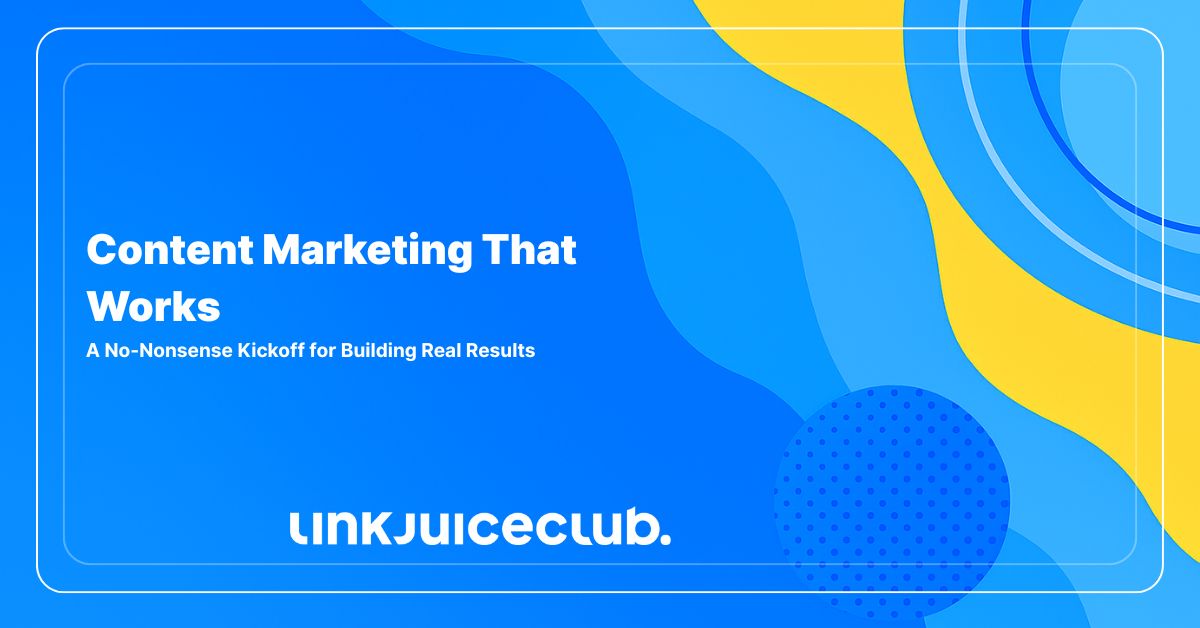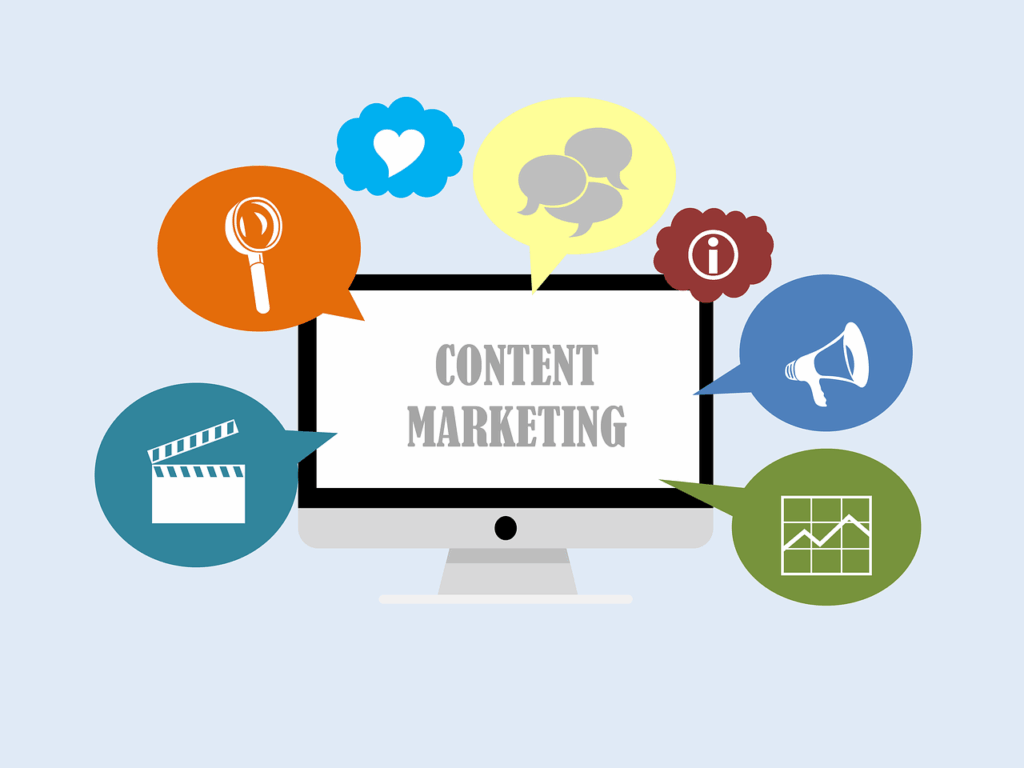
Content Marketing That Works: A No-Nonsense Kickoff for Building Real Results
Content marketing has a way of sounding like a buzzword at a sales conference where everyone’s wearing the same shade of hopeful. Strip it down, though, and it’s just a practical method of saying something useful often enough that people remember who said it. When it works, it doesn’t feel like a strategy.
Plenty of businesses try content marketing like they’re throwing darts blindfolded, hoping one lands somewhere impressive. This guide takes the blindfold off. It lays out what actually powers a content strategy worth sticking with. Think foundations, structure, clear steps. None of the airy fluff that sounds good and delivers nothing.
For those who’ve tried their hand already and ended up with more effort than impact, there’s clarity here. For those about to take the first step, there’s grounding. It’s not a cheat sheet, it’s a manual you won’t want to pretend you’ve read. Everything inside is built to keep your content working in real time for real people, without shouting for attention or waving for clicks like it’s stranded at sea.
What Content Marketing Actually Is (Without the Sales Seminar Gloss)
Content marketing gets results by doing one simple thing: giving people something useful before asking for anything in return. That’s the deal. You offer value upfront, such as information, clarity, guidance, even a bit of entertainment, and people pay attention because it helps them. It doesn’t rely on gimmicks. It works because it respects the audience’s time.
This approach shows up where people already are. Print still plays a role for some. Online, the options are wide open: articles, videos, newsletters, social posts, tutorials, podcasts. Pick what suits the people you want to reach, then give them something they can actually use.

It’s part of every solid marketing setup for one reason. It builds interest without chasing it. When someone learns something from a brand, they remember it. That memory turns into trust. Trust builds the kind of attention you don’t need to beg for.
Why Content Marketing Matters
Long before anyone typed a blog or uploaded a video, people were already using stories to share ideas, pass on knowledge, and make sense of their surroundings. From cave paintings in Sulawesi to modern data visualisations on screens no bigger than a palm, the impulse to communicate has never gone out of fashion, it has only adapted to new tools, new languages, and a faster pace.
In a world where digital noise continues to grow louder with every second, attention becomes harder to earn and even harder to keep. Pop-ups, autoplay videos, blinking banners, and relentless promotions fill screens with distraction. It’s no surprise, then, that people are installing ad blockers at scale, with billions in advertising spend quietly vanishing before it ever reaches the audience it was meant for.
Against that backdrop, content marketing provides an alternative that respects the user’s time while still delivering business results. Instead of shouting for attention, it offers relevance. Instead of interruption, it creates moments worth engaging with.
A Practical Approach for Businesses That Want Results
At its core, content marketing is a method for reaching people by being useful before being promotional. The work involves creating material your audience genuinely needs, placing it where they already spend time, and letting relevance do the heavy lifting. It works best when backed by strategy, supported by research, and delivered with consistency. When done properly, it brings in leads, keeps customers engaged, and proves the business knows what it’s talking about.
To make this approach more than just a buzzword, each piece of content needs structure, purpose, and distribution. Here’s how to build a working content system from the ground up.
📝👣A Style Guide Is Step One
Without a fixed standard, content becomes inconsistent. A style guide addresses this by setting voice, grammar rules, terminology, formatting, and usage. The outcome is simple: everything sounds like it came from the same place. That applies to blog posts, product pages, help articles, and social copy.
It also speeds up production. Writers focus on ideas rather than asking about commas. Editors work from a clear baseline. New hires get up to speed without long onboarding. Once the structure is in place, it becomes easier to scale output without drifting away from the brand’s core voice.
📈🔄How Content Marketing Changed (and What Hasn’t)
Although content formats evolved, the fundamentals stayed the same. The earliest examples, travel guides, product manuals, sponsored entertainment, used stories and advice to support business objectives. Today’s equivalents include blog articles, videos, explainers, and toolkits.
Delivery methods now include digital platforms, but the principle remains clear. Provide value to a clearly defined audience, do it consistently, and measure the results. That formula worked before the internet and still applies in every sector today.
🎯🎬Purpose Comes Before Production
No content piece should begin without a reason to exist. Start by defining the goal. That could mean explaining a product, answering a buyer concern, improving visibility, or supporting onboarding. Once that’s clear, shape the content to fit.
Next, map the content to the funnel:
- 🔍⬆️ Top: introduce a topic or pain point
- ⚖️➡️ Middle: explore comparisons or guide evaluation
- ✅⬇️ Bottom: answer final objections or clarify next steps
Each layer addresses a different mindset. A tutorial on setup supports an existing customer. A template download attracts early-stage prospects. A case study builds confidence in decision-makers. Purpose links each action to outcome.
🧩👥Choose Formats That Fit the Audience
Different formats suit different situations. A technical reader may want detailed walkthroughs. A time-poor executive may prefer a digestible briefing. Choosing content types should depend on who the audience is, what they already know, and how they prefer to learn.
Examples of formats that often work:
- 📚 In-depth guides
- 🛠️ How-to articles
- 🎥 Video explainers
- 📧 Short email sequences
- 📊 Case studies
- 🎤 Webinars
- 📄 Downloadable templates
- 📲 Social carousels
- 📽️ Slide decks
Instead of sticking to one format, rotate based on the message and the distribution plan. Each version carries the same core idea but meets users where they are.
🏆✅ What Leading Brands Are Doing Right
Successful content teams don’t treat this as an add-on. They build entire strategies around education, problem-solving, and long-term engagement. The work starts with research and ends in refinement.
Common moves from high-performing brands:
- Software firms build searchable knowledge libraries
- Travel companies produce ongoing destination content with local insight
- Finance companies publish timely analysis tied to market events
- Health providers create plain-language explainers backed by professionals
They don’t just publish regularly. They publish material the audience returns to.
🛠️⚡ Use Tools That Streamline the Process
Content production involves many steps. Doing it manually creates bottlenecks. The best content marketers rely on tools for each part of the workflow.
Essential categories include:
- Topic research (e.g. Semrush, Ahrefs)
- Collaborative writing (e.g. Google Docs, Notion)
- Project tracking (e.g. Trello, Airtable)
- SEO guidance (e.g. Clearscope, Surfer)
- Analytics (e.g. Google Analytics, Looker Studio)
- Visual creation (e.g. Canva, Figma)
Building a basic tech stack early improves consistency, removes friction, and allows teams to focus on ideas instead of chasing updates or fixing formatting.
🎯📤 Distribute With Precision
Creating strong content without distributing it properly leads to wasted effort. Once published, each piece needs a plan to reach the audience it was made for. Owned channels such as email and website are the most reliable. External platforms help extend reach.
Distribution options:
- Company newsletters
- LinkedIn posts or articles
- Syndication through Medium
- Shared links in Slack communities or private groups
- Mentions in partner campaigns
- Threads on relevant forums or subreddits
- Targeted social media promotion
- Feature placement in apps or dashboards
Reuse helps content live longer. A guide can become a series. A webinar can break into short video clips. A blog post can power a thread or checklist.
🔗🔍 How SEO Connects With Content
Search engine visibility depends on strong content. Structured pages that match search intent stand a better chance of appearing in front of qualified traffic. SEO adds a layer of targeting to the content work already underway.
To align with search best practices:
- Focus each page on one idea or question
- Use headings to break up structure
- Optimise metadata (title, description, URL)
- Include internal links that support user journeys
- Ensure fast loading and mobile accessibility
Content alone builds engagement. SEO ensures that engagement grows steadily over time.
📅🚀 Keep Content Running With a Calendar
An editorial calendar removes chaos from the equation. It provides a view of what’s coming, what’s live, and what’s overdue. A well-maintained calendar helps teams stay aligned, plan resources, avoid redundancy, and adapt to new opportunities.
A working calendar tracks:
- Topics tied to business goals
- Assigned owners
- Deadlines and review stages
- Formats and planned channels
- Performance checks after publishing
Use tools that support flexibility. Notion, Trello, and Airtable all offer editorial calendar templates. Match the setup to your workflow, then refine as you grow.
The Practical Impact of High-Performing Content Marketing
Effective content marketing operates with structure, data, and purpose. When executed well, it improves engagement, builds brand credibility, generates qualified leads, and reduces acquisition costs, all without relying on aggressive tactics. Below is a breakdown of the specific reasons why it works and what modern content must deliver.

🤝✨Quality Content Builds Trust and Engagement
People now expect content to offer more than surface-level insights. Regardless of brand size, audiences look for material that goes deeper, offers reliable sources, and feels grounded in real knowledge. The demand for authenticity is rising, especially in a digital environment dominated by filters, automation, and misinformation.
Longer, more detailed pieces tend to carry more perceived value than brief summaries. Comprehensive content that explores a topic thoroughly tends to attract more attention, generate more shares, and stay relevant for longer. Providing depth positions a brand as a resource, rather than a distraction.
🎯🧠 Personalisation Drives Relevance
Content works best when it meets people where they are. Audiences engage more with material that matches their individual interests, behaviours, and needs. As people grow used to algorithm-driven platforms that suggest what matters most to them, content marketers must adopt a similar mindset.
YouTube’s performance illustrates this clearly. With over 2 billion logged-in users per month, the platform shows that people prefer content tied to personal interests over content featuring celebrity endorsement. Personalisation has become a baseline expectation. When content aligns with a user’s goals or questions, engagement rises naturally.
🔍❤️ Transparency Builds Long-Term Loyalty
Consumers no longer see themselves as passive recipients of information. They expect to play an active role in the relationship. That means brands must communicate honestly, especially when making changes to products, services, or policies.
More than half of online users believe that companies should demonstrate accountability and openness on platforms like social media. Transparency, when handled well, boosts credibility and drives deeper connection.
💡🤝 Strong Content Converts Without Pressure
High-quality content leads to stronger conversion rates over time. On average, content-focused marketers report six times the conversion rate of those using more traditional methods. That difference is driven by one factor: relevance. People are more likely to take action after reading or watching something that answers a question, resolves uncertainty, or shows practical value.
In B2B environments, content drives a measurable share of conversions as well. To increase results, brands must find and refine their content differentiation factor (CDF)—a distinct voice, unique insight, or original presentation style that makes their material stand out in a crowded field.
💰📈 It Cuts Costs While Boosting Lead Volume
Content marketing is cost-efficient. Research shows that it reduces marketing spend by 62% while delivering three times the number of leads when compared to traditional channels. This matters across all sectors, especially for businesses with lean teams or limited budgets.
Instead of relying solely on ad spend, content-driven brands attract opt-in subscribers, search traffic, and word-of-mouth exposure. This compounds over time, building a base of pre-qualified prospects who already understand the brand and trust its expertise before making a purchase decision.
🌐🚀 The Modern Landscape Goes Far Beyond Blogging
While blogging remains a foundation, modern content marketing expands far beyond written posts. Audiences are spread across different platforms and formats, and reaching them requires a more varied content strategy.
Current channels include:
- Podcasts
- Ebooks
- Webinars
- Social media updates
- Email series
- Online courses
- Video explainers
- Live streams
- Influencer-led content
- Interactive tools
Emerging trends include voice-search optimisation, augmented reality content, direct engagement via chat platforms, and dynamic personalisation based on behavioural data.
The more channels a business can manage effectively, the broader the reach. Content marketing today requires flexibility, responsiveness, and a clear understanding of how each platform contributes to the broader plan. The opportunity is large and growing.
Build Momentum with a Clear Content Plan
Consistent, focused content earns attention, strengthens relationships, and drives results. With the right goal in place, your business attracts qualified visitors and creates steady demand across every stage of the customer journey.
Use your strengths. Document your plan. Publish regularly. Track outcomes. Adapt as you grow.
This approach turns your expertise into action. It keeps your audience engaged and your brand front of mind when decisions are made. Start with one useful piece. Build from there. The impact follows.





